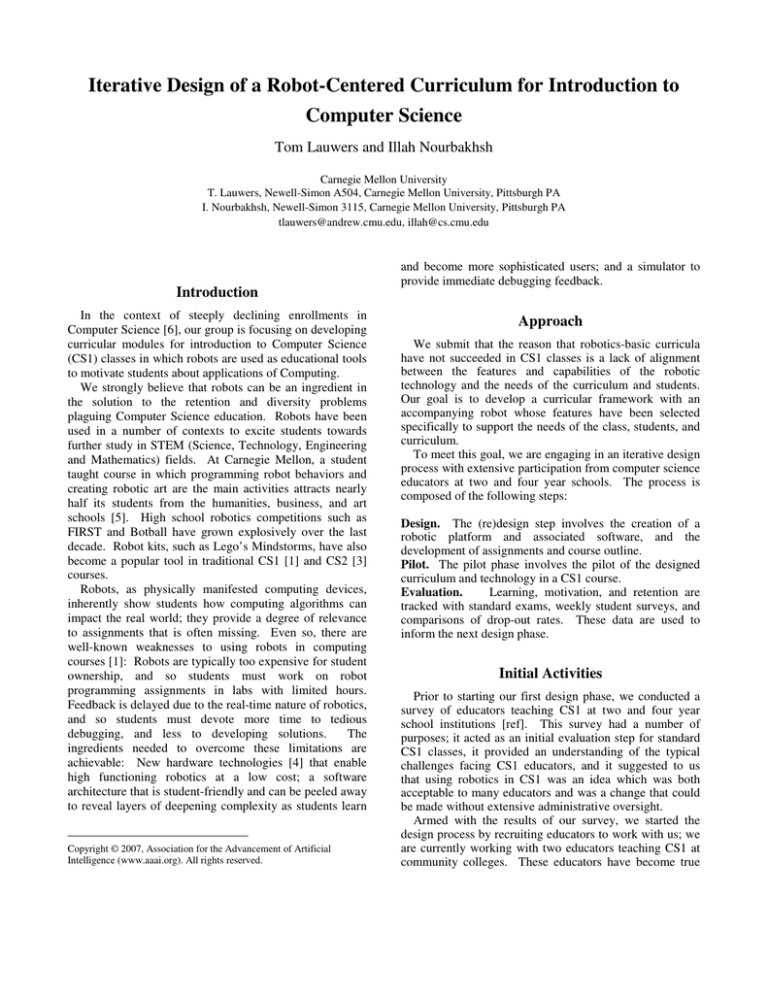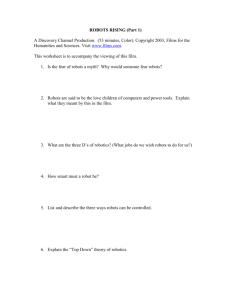
Iterative Design of a Robot-Centered Curriculum for Introduction to
Computer Science
Tom Lauwers and Illah Nourbakhsh
Carnegie Mellon University
T. Lauwers, Newell-Simon A504, Carnegie Mellon University, Pittsburgh PA
I. Nourbakhsh, Newell-Simon 3115, Carnegie Mellon University, Pittsburgh PA
tlauwers@andrew.cmu.edu, illah@cs.cmu.edu
Introduction
In the context of steeply declining enrollments in
Computer Science [6], our group is focusing on developing
curricular modules for introduction to Computer Science
(CS1) classes in which robots are used as educational tools
to motivate students about applications of Computing.
We strongly believe that robots can be an ingredient in
the solution to the retention and diversity problems
plaguing Computer Science education. Robots have been
used in a number of contexts to excite students towards
further study in STEM (Science, Technology, Engineering
and Mathematics) fields. At Carnegie Mellon, a student
taught course in which programming robot behaviors and
creating robotic art are the main activities attracts nearly
half its students from the humanities, business, and art
schools [5]. High school robotics competitions such as
FIRST and Botball have grown explosively over the last
decade. Robot kits, such as Lego’s Mindstorms, have also
become a popular tool in traditional CS1 [1] and CS2 [3]
courses.
Robots, as physically manifested computing devices,
inherently show students how computing algorithms can
impact the real world; they provide a degree of relevance
to assignments that is often missing. Even so, there are
well-known weaknesses to using robots in computing
courses [1]: Robots are typically too expensive for student
ownership, and so students must work on robot
programming assignments in labs with limited hours.
Feedback is delayed due to the real-time nature of robotics,
and so students must devote more time to tedious
debugging, and less to developing solutions.
The
ingredients needed to overcome these limitations are
achievable: New hardware technologies [4] that enable
high functioning robotics at a low cost; a software
architecture that is student-friendly and can be peeled away
to reveal layers of deepening complexity as students learn
Copyright © 2007, Association for the Advancement of Artificial
Intelligence (www.aaai.org). All rights reserved.
and become more sophisticated users; and a simulator to
provide immediate debugging feedback.
Approach
We submit that the reason that robotics-basic curricula
have not succeeded in CS1 classes is a lack of alignment
between the features and capabilities of the robotic
technology and the needs of the curriculum and students.
Our goal is to develop a curricular framework with an
accompanying robot whose features have been selected
specifically to support the needs of the class, students, and
curriculum.
To meet this goal, we are engaging in an iterative design
process with extensive participation from computer science
educators at two and four year schools. The process is
composed of the following steps:
Design. The (re)design step involves the creation of a
robotic platform and associated software, and the
development of assignments and course outline.
Pilot. The pilot phase involves the pilot of the designed
curriculum and technology in a CS1 course.
Evaluation.
Learning, motivation, and retention are
tracked with standard exams, weekly student surveys, and
comparisons of drop-out rates. These data are used to
inform the next design phase.
Initial Activities
Prior to starting our first design phase, we conducted a
survey of educators teaching CS1 at two and four year
school institutions [ref]. This survey had a number of
purposes; it acted as an initial evaluation step for standard
CS1 classes, it provided an understanding of the typical
challenges facing CS1 educators, and it suggested to us
that using robotics in CS1 was an idea which was both
acceptable to many educators and was a change that could
be made without extensive administrative oversight.
Armed with the results of our survey, we started the
design process by recruiting educators to work with us; we
are currently working with two educators teaching CS1 at
community colleges. These educators have become true
design partners, suggesting changes to software and
hardware, coming up with assignment ideas, and affording
us opportunities to pilot our curriculum.
Curriculum design was guided by several conclusions
from our survey; educators teaching Java were most
enthusiastic about using robots, most educators wanted a
new curriculum to be linked to a textbook, robots could be
introduced into a class with minimal administrative
paperwork so long as the programming language did not
change and the course schedule was minimally affected.
We focused on Java and chose a specific textbook to link
to our curriculum. We took care to ensure that each
assignment developed was focused on teaching CS
concepts; we used the prior assignments from our design
partners as a baseline and analyzed these to ensure our
assignments were similar conceptually.
We also
minimized the amount of robot-specific information
students need to know.
Figure 2: Students working in the robotics lab
retention rates of a comparable course taught concurrently
by another educator. Additionally, we are surveying
students upon the completion of each assignment to
determine which assignments were interesting, and to track
motivation throughout the semester.
We will use the data from the Fall 2007 courses to
determine which assignment themes and technological
features to keep and expand upon and which to remove.
Once this analysis is complete, we plan to redesign both
the curriculum and technology in Spring 2008, and pilot
the new course at three or four educational institutions in
the Fall of 2008.
References
Figure 1: First Design of Robotic Platform
Our technology goal for the first design cycle was to
develop a robotic platform which had a large set of features
at a reasonable cost; our aim was to maximize the number
of features which could be tested, and then develop an
optimal feature set to guide our second design. Our final
design (figure 1) is an iRobot Create robotic platform
combined with a Qwerk controller; the Qwerk is wirelessly
tethered to a student’s computer. This combination of
technologies has the following capabilities: bumper-based
obstacle detection, encoder-based movement tracking,
vision through a webcam, full audio including arbitrary
text to speech, color and intensity variable LEDs, and
access to real-time RSS feeds.
In Fall 2007 we began two pilots with our design
partners (figure 2). These pilots involve over 60 students
and 15 robots at two community colleges, one in
Pennsylvania and one in California. In the Pennsylvania
course, our design partner has kept detailed records of
retention and performance of students going back six
years; our course will track performance and retention, and
compare them with previous figures as well as the
[1] Fagin, B. & Merkle, L., “Measuring the Effectiveness
of Robots in Teaching Computer Science.” pg. 307311, SIGCSE 2003.
[2] Lauwers, T. & Nourbakhsh, I., “Informing Curricular
Design by Surveying CS1 Educators”, In Proceedings
of AMiRE, 2007.
[3] McNally, M., “Walking the Grid: Robotics in CS2.”
In Proceedings of the 8th Austalian conference on
Computing education, pg 151-155, 2006.
[4] Nourbakhsh, I., et al., “A Roadmap for Technology
Literacy and a Vehicle for Getting There:Educational
Robotics and the TeRK Project.” In Proceedings of
IEEE RO-MAN 2006.
[5] Shamlian S. et al., “Fun with Robots: A StudentTaught Undergraduate Robotics Course.” pg. 369-374,
ICRA 2006.
[6] Vegso, Jay. “Interest in CS as a major drops among
incoming freshmen.” Computing Research News, May
2005.





